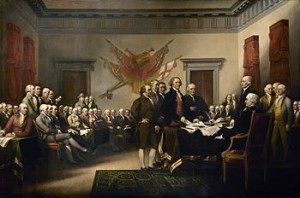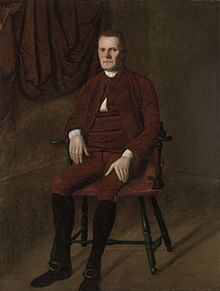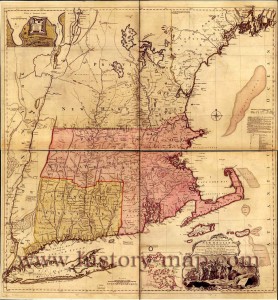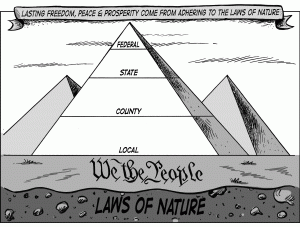By Jordan Forry
Roger Sherman represents one of the most underappreciated founding fathers of the United States. This fact is lamentable, given Sherman’s immense contributions to the founding of this country. In addition to holding the distinction of being the only founder to participate in authoring and signing all four significant founding documents (The Articles of Association, The Declaration of Independence, The Articles of Confederation, and the Constitution), he also deserves credit for enshrining federalism in the US Constitution and for suggesting many of the key compromises that led to the formation of a broad coalition of interests that could support the Constitution (Hall, 1-3).
Historian Gordon Wood summarizes most of the founding fathers as gentlemanly figures. By a gentleman, Wood means, “All those who have received a liberal education,” and who are not, “Themselves husbandmen, mechanics, or laborers” (Wood, 15). These gentleman could afford to avoid labor and instead pursue academic study or public service. By these standards, Sherman only became a gentleman later in life and perhaps best mirrors Benjamin Franklin’s transformation from a print apprentice to a respected statesman and scientist (Wood, 67-90).
Born the son of a small Massachusetts farmer on April 19, 1721, Sherman spent the first twenty years of his life in Canton, Massachusetts as a farm hand. During this period, Sherman was able to attend primary and secondary education; however, he did not attend college. In response to his father’s death in 1742, Sherman moved to New Milford Connecticut to open a store with his brother. In addition to shopkeeping, Sherman took up surveying and advanced in the profession to become New Haven County Surveyor. From this position, Sherman gained access into Connecticut political circles, and in 1753, he was elected to the Connecticut General Assembly and was admitted to the Litchfield bar. From this point onward, Sherman remained a political figure, with his only other employment being law and occasional business ventures (Collier, np). Therefore, 1753 represents the transition in Sherman’s life from yeoman farmer/merchant to gentleman.
Like other founders, Sherman was deeply influenced by the Enlightenment ideals of liberty, republicanism, and representative government. The roots of these ideals in Sherman’s ideology extend back before the outbreak of the Revolution. In 1752, Sherman published an article entitled “A Caveat Against Injustice,” in which he argued against the prevalence of cheap paper money being issued by the New England Colonies, especially Rhode Island (Hall, 43). In this essay, he argues that governments are limited in what actions they can take when infringing on personal liberty by stating, “And I think it is a Principle that must be granted that no Government has Right to impose on its Subjects any foreign Currency to be received in Payments as Money which is not of intrinsick Value” (“A Caveat,” sec 11). For the Connecticut government to force its residents to accept Rhode Island’s inflated currency as payments for debt would violate Connecticut debt holders’ rights to their private property and would be an unjustifiable government intrusion into the economic sphere. Sherman’s views on Connecticut’s monetary policies demonstrate that he recognized that limits to government power exist and the importance of safeguarding personal liberty and rights.
This belief in a government limited by the natural rights of the people again surfaced in Sherman’s response to the passage of the Stamp Act of 1765 by the British Parliament. Sherman opposed the Act, which taxed colonial paper products, on the grounds that Parliament lacked the authority to tax the colonies without the colonies first having representation in Parliament. In fact, Sherman went farther than even many of his contemporaries by saying that Parliament also lacked the authority to regulate the colonies. In response, Sherman led a committee of men selected from the Connecticut Assembly in drafting a list of grievances that the colony of Connecticut had with the British Crown. In a letter to Thomas Cushing, Sherman expressed his view by stating that, “No Laws bind the people but such as they consent to be governed by.” (Hall, 49-50).

Roger Sherman and the Committee of Five presenting the Declaration of Independence to the Continental. Congress. Photo Credits: Wikipedia
As the colonial crisis worsened, Connecticut appointed Sherman in 1774 to serve in the Continental Congress. In June of 1776, Sherman was selected to serve on the Committee of Five that would draft and present the Declaration of Independence to the Continental Congress (Hall, 53-56). While Jefferson often receives all of the credit for the inspiration and ideas that went into the Declaration, perhaps Sherman deserves more credit given his role in drafting Connecticut’s List of Grievances eleven years earlier.
In addition to Sherman’s previous accomplishments, his greatest contribution to the founding of the country was his ability to shape the Constitution into a document that promotes federalism, the sharing of power between the state and federal governments. In the years leading up to 1787, Sherman believed that a new Constitution would be unnecessary, and he only wanted to amend the Articles of Confederation. However, once at the Constitutional Convention, he realized the necessity of complete reform and worked diligently to craft a perfect document. Sherman wished to ensure that states did not lose too much power under the new Constitution. When delegates from the large and small states could not agree on the way to allocate representatives in the legislative branch, Sherman proposed a compromise that would allocate representatives in one house of Congress by population and in the other, the Senate, equally among the states (Hall, 92-96). Sherman was also able to convince the delegates to require the state legislatures to appoint the Senators, instead of the people. The desired results of these two proposals would be increased power for the states in the federal government and the ability of the Senate to remain disinterested by making Senators accountable to the states, not the popular whims of the people (Fiske, 282-284).
Gordon Wood considers disinterestedness, or “Rising above…and being unselfish or impartial where an interest may be present,” to be a defining characteristic of the founders (Wood, 16). From George Washington to Benjamin Franklin, all of Wood’s characters exhibit this quality, and Sherman is no exception. In a letter to John Adams in 1789, Sherman understates his expectation that the Senate will be disinterested by stating, “Senators will doubtless be in general some of the most respectable citizens in the states for wisdom and probity… they will consider that a fair and upright conduct will have the best tendency to preserve the confidence of the people and of the states” (Sherman, 1789). Going even further, Sherman later in life stated that legislators should act according to their own judgements and not according to public opinion, and if the two are contrary, “He must be bound by every principle of justice to disregard them (the people)…” (Boyd, 231).
In conclusion, Roger Sherman represents one of the most influential founders. Like most founders, Sherman received inspiration from the Enlightenment ideals of liberty, republicanism, and individual rights. Resembling his peers, he can best be described as a gentleman performing his duty as a disinterested statesman. However, Roger Sherman deserves to stand apart from other founders due to his substantial impact on the founding from the Declaration through the Constitution. No other founder can boast such great influence on so much of the founding of the United States.
Works Referenced:
Boyd, Julian. “Roger Sherman: Portrait of a Cordwainer Statesman.” New England Quarterly 5, no. 2 (Apr. 1932): 221-236.
Collier, Christopher. “Roger Sherman.” In American National Biography Online.http://www.anb.org/articles/01/01-00831.html?a=1&g=m&n=Roger%20Sherman&ia=-at&ib=-bib&d=10&ss=2&q=3.
Fiske, John. The Critical Period of American History: 1783-1789. Boston: Houghton Mifflin Company, 1916.
Hall, Mark. Roger Sherman and the Creation of the American Republic. Oxford: Oxford University Press, 2013.
Sherman, Roger. “A Caveat Against Injustice.” Original publication, 1752.Republished in 2003, http://www.constitution.org/cmt/rsherman/caveatagainst.htm.
Sherman, Roger. Letter to John Adams. July 1789. Online Source: University of Chicago. Last updated 2014. http://press-pubs.uchicago.edu/founders/documents/a2_2_2-3s46.html.
Wood, Gordon. Revolutionary Characters: What Made the Founders Different.London: Penguin Books, 2006.




Received, thanks